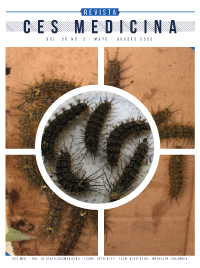Segmental neurofibromatosis, case report
DOI:
https://doi.org/10.21615/cesmedicina.6703Keywords:
neurofibromatosis 1, neurofibromatosis type V, segmental neurofibromatosis, neurofibromatosesAbstract
Introduction: neurofibromatosis is a genetic disorder that affects the growth of neural tissues, with an incidence of 1 in 4 000, with impact on life expectancy due its association with neoplasms and vascular disease. segmental neurofibromatosis is a subtype of neurofibromatosis type 1, with an approximate incidence of 1 in 20 000 to 25 000 people, it is characterized by skin lesions that affects a body segment without crossing midline, they generally have no family history or systemic involvement. Clinical case: a 63-year-old female patient with dermatosis affecting the posterior trunk unilaterally at the level of dermatomes t10-t11, characterized by multiple exophytic, dome-shaped, millimeter sized neoformations, soft in consistency and depressible on palpation. the histopatologic study of one of them confirmed the diagnosis of neurofibroma. the patient did not present neurological or ocular involvement, without affection in relatives. diagnosis of segmental neurofibromatosis was made. Conclusions: segmental neurofibromatosis is a rare pathology, although it is possibly underdiagnosed due its asymptomatic nature, which causes an apparent low incidence. patients may present variable systemic penetrance and a similar risk of neoplasm compared to patients with neurofibromatosis type 1. despite the benign nature reported in the literature, we suggest a multidisciplinary approach to patients.
Downloads
References
Tamura R. Current Understanding of Neurofibromatosis Type 1, 2, and Schwannomatosis. Int J Mol Sci 2021 May 29;22(11):5850. doi: 10.3390/ijms22115850. PMID: 34072574; PMCID: PMC8198724.
Kallionpää RA, Uusitalo E, Leppävirta J, Pöyhönen M, Peltonen S, Peltonen J. Prevalence of neurofibromatosis type 1 in the Finnish population. Genet Med 2018;20(9):1082–6. doi: 10.1038/gim.2017.215. PMID: 29215653.
Rasmussen SA, Yang Q, Friedman JM. Mortality in neurofibromatosis 1: an analysis using U.S. death certificates. Am J Hum Genet 2001;68(5):1110–8. doi: 10.1086/320121. Epub 2001 Mar 28. PMID: 11283797; PMCID: PMC1226092.
Crowe FW, Schull WJ, Neel JV. A clinical, pathological and genetic study of multiple neurofibromatosis. Springfield, III: Charles C Thomas Publishers; 1956. pp. 74pp. 80–2.–139.pp. 153–9.
Riccardi VM. Neurofibromatosis: Clinical heterogeneity. Curr Probl Cancer. 1982;7(2):1–34. doi: 10.1016/s0147-0272(82)80016-0.
Roth RR, Martines R, James WD. Segmental neurofibromatosis. Arch Dermatol 1987; 123:917-20.
Gabhane SK, Kotwal MN y Bobhate SK, Segmental neurofibromatosis: A report of 3 cases, Indian J Dermatol 2010; 55:105-8. doi: 10.4103/0019-5154.60366.
Verduzco Martinez AP, Crocker Sandoval AB, Sanchez Duenas LE y Guevara Gutierrez E, neurofibromatosis segmentaria verdadera, Dermatología Rev Mex 2011; 55(2): 99-101.
Tinschert S et al., Segmental neurofibromatosis is caused by somatic mutation of the neurofibromatosis type 1 (NF1) gene, Eur J Hum Genet 2000; 8:455-9. PMID: 10878667; oi: 10.1038/sj.ejhg.5200493
Lammoglia OL, Rodríguez SM, Martínez LE, et al. Neurofibromatosis segmentaria: Reporte de un caso . Dermatología Cosmética, Médica y Quirúrgica. 2019;17(3):196-199.
Rapini RP, Practical dermatopathology, 2ª ed., Pekin, Elsevier Saunders, 2012, pp. 367-8.
Herrera Ceballos E, Dermatopatología: correlación clínico-patológica, 1ª ed., Madrid, Area Cientifica Menarini, 2007, pp. 405-9.
Sobjanek M, Dobosz-Kawałko M, Michajłowski I, P ksa R y Nowicki R, Segmental neurofibromatosis, Post py Dermatologii i Alergologii 2014; 31(6):410-412.
Cohen PR. Segmental neurofibromatosis and cancer: Report of triple malignancy in a woman with mosaic Neurofibromatosis 1 and review of neoplasms in segmental neurofibromatosis. Dermatol Online J. 2016;22(7). PMID: 27617721.
Santos Alarcón S, García-Briz MI, Mateu-Puchades A. Comorbidity associated to segmental neurofibromatosis. Med Clin (Barc). 2019;152(1):33. doi: 10.1016/j.medcli.2018.02.002.
Cohen PR, Incidental (malignancy) and coincidental (idiopathic polydactylous longitudinal erythronychia) conditions in patients with segmental neurofibromatosis, Cutis 2013; 91(4):179-80.
gieri M et al., Ophthalmological manifestations in segmental neurofibromatosis type 1, Br J Opthalmol 2004; 88:1429-33.
Downloads
Published
How to Cite
Issue
Section
License
Copyright (c) 2022 CES Medicina

This work is licensed under a Creative Commons Attribution-NonCommercial-ShareAlike 4.0 International License.
Derechos de reproducción (copyright)
Cada manuscrito se acompañará de una declaración en la que se especifique que los materiales son inéditos, que no han sido publicados anteriormente en formato impreso o electrónico y que no se presentarán a ningún otro medio antes de conocer la decisión de la revista. En todo caso, cualquier publicación anterior, sea en forma impresa o electrónica, deberá darse a conocer a la redacción por escrito.
Plagios, duplicaciones totales o parciales, traduccones del original a otro idioma son de responsabilidad exclusiva de los autores el envío.
Los autores adjuntarán una declaración firmada indicando que, si el manuscrito se acepta para su publicación, los derechos de reproducción son propiedad exclusiva de la Revista CES Medicina.
Se solicita a los autores que proporcionen la información completa acerca de cualquier beca o subvención recibida de una entidad comercial u otro grupo con intereses privados, u otro organismo, para costear parcial o totalmente el trabajo en que se basa el artículo.
Los autores tienen la responsabilidad de obtener los permisos necesarios para reproducir cualquier material protegido por derechos de reproducción. El manuscrito se acompañará de la carta original que otorgue ese permiso y en ella debe especificarse con exactitud el número del cuadro o figura o el texto exacto que se citará y cómo se usará, así como la referencia bibliográfica completa.
| Article metrics | |
|---|---|
| Abstract views | |
| Galley vies | |
| PDF Views | |
| HTML views | |
| Other views | |



